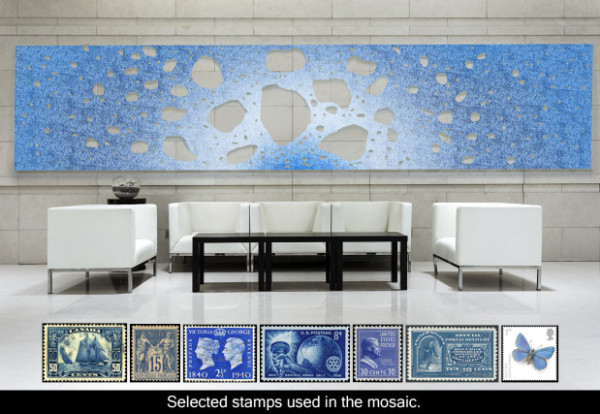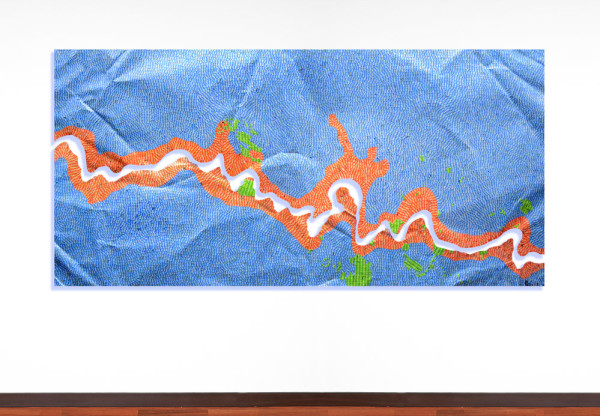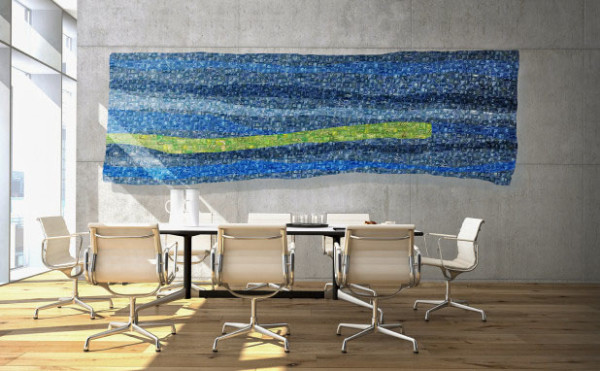Third of a 3-part series on the business of art consulting by Peter Hite

Although it’s certainly a creative and fulfilling outlet, at the end of the day, art is how many artists make their living. Which means that money has to play a role. And it’s the same for art consultants! This is their business, and they have to make a profit in order to sustain themselves.
At this point, you may be wondering how the business side of art consulting could possibly impact you. As long as they’re willing to pay your rates, it shouldn’t really matter about the rest of their business operations, right?
While that’s true to an extent, the fact is that here—as with any profession—knowledge is power. The more you know about the business of art consulting, the more you can use that knowledge to grow your own business as an artist.
In the first two articles, we covered how to find and communicate with art consultants, and now we’ll be taking a deeper dive into their business operations: how they make money and how financial practices vary across the different segments. At the end, we’ll tie up everything we’ve discussed by looking at a typical commission funnel from start to finish.
Money Talk: The Business Side of Art Consulting
Of my interviews with 26 art consultants, what perhaps struck me most was how different each firm is—and nowhere was this more apparent than in their business operations.
How Art Consultants Make Money
Although the art consulting market is fragmented, nearly all firms make profit in essentially the same way: by purchasing artwork wholesale from artists, marking it up a certain percentage, and then selling it to clients at an increased retail price. Some firms will charge for services, too.
To make sure we’re on the same page, let’s first review the definitions of these important financial terms.
- Wholesale: the amount of money charged by the artist to the art consultant
- The consultant pays the artist $1 for the artwork. $1 is the wholesale price.
- Markup: the percentage that the wholesale price is increased by the consultant
- The consultant charges the client $2 for the artwork. The artwork has a 100% markup.
- Retail: the price that the client pays for the artwork
- The client pays the consultant $2 for the artwork. $2 is the retail price.
- Profit: the difference between the retail price and the wholesale cost (including any additional expenses like shipping and installation)
We can find the art consultant’s profit in this scenario with a simple calculation:
|
Client pays for artwork |
$2.00 |
Retail price |
|
Consultant’s costs |
$1.00 |
Wholesale price of artwork |
|
.15 |
Shipping |
|
|
.05 |
Installation |
|
|
$1.20 |
Total cost of artwork |
|
|
Consultant’s profit |
$.80 |
What’s not included in this example? The consultant’s time. Client and artist communications have to come out of that 80 cents of profit—which explains why art consultants can’t afford to respond to every single email that comes their way. Some firms even charge consulting fees to offset these additional expenses.
That 80 cents also helps sustain the firm while developing new business. As Amy Parry of Amy Parry Projects explains, “My firm is relatively new, so I spend a lot of my time creating materials to apply for new projects—all for free. There is a lot of upfront work that may not pay off.”
Art Consultants’ Markup Fees: No Set Standard
From this example, you can see that an art consultant’s markup fee has a huge impact on the profit that the consultant will make. The significance of markup fees in the commissioned art process made me wonder: Is there an industry standard for marking up? How do art consulting firms choose the percentage?
What I found from my interviews is that there is no industry standard and that markup varies dramatically depending on the segment, size of the firm, and number of services provided by the consultant.
Below is the (extremely wide) range of markup percentages that I found in my interviews.
- 0%: This markup was found with a general healthcare design firm, not an art consulting firm. This firm bills only for time and includes artist selection within their overall project scope.
- 15 – 25%: This markup was found in commercial projects in situations where the art consultant shares the markup with the gallery that represents the artist.
- 100%: This was the most common markup found across all segments.
- 100% plus billable time: This rate was found in healthcare, especially when the firms also provided design services.
- 250%: This was only found in hospitality and applied mostly to reproductions. It is not as common for commissions.
Markup Fees by Design Area: Healthcare vs. Hospitality vs. Commercial
As demonstrated above, there is no set formula for how art consultants make money. Even within the same design area, the practices can differ greatly. However, there were some overall trends that emerged from my interviews—so let’s look at the common markup structures I found for commissioned art in the three major design areas.
Healthcare
- Most healthcare art consultants mark up artwork 100%.
- The bigger firms seem to charge 100% markup plus consulting fees.
- Some outliers mark up artwork less than 50%, but these firms rely on design fees to generate revenue.
Hospitality
- 100%-plus is the most common markup across the board, including both commissioned and noncommissioned hospitality artwork.
- Some smaller firms, as well as consultants who crossover, mark up less (typically at a flat rate of 100%).
Commercial/Corporate
- Most commercial art consultants mark up artwork 100%.
- Some firms only mark up 15% to 25%, if they’re working with a gallery.
Who Cares? How Art Consultants’ Markup Impacts You as an Artist
So what does all of this money talk mean for you? As an artist, I shouldn’t really care what the art consultant charges the client, right?
It might not mean a lot on the surface, but I’ve found that knowing the markup does matter. After all, if you’re going to be active in an industry, it’s worthwhile to know that industry—even the parts that may not seem to directly impact you. Being aware of what art consultants tend to charge gives me a snapshot of the industry and shows me how my wholesale price fits into the bigger picture.
Another more specific way that markup knowledge affects my business practice is in the realm of negotiating. For example, remember that healthcare design firm that charged 0% markup? If you know that your consulting firm isn’t taking a large piece of the art budget for themselves, you might be able to charge a higher wholesale price. (Check out step #3 in the commission funnel below for some more specific tips on negotiation.)
Even if this knowledge doesn’t change your own pricing strategy, I find that it’s just part of being an informed professional. Knowing a consultant’s markup hasn’t earned or lost me a project, but understanding the financial side of the industry overall has helped me better orient and position myself in it.

Putting Everything Together: How the Commission Process Works
We’ve now arrived at the final part of this series. So far, we’ve talked about how to find art consultants, how to establish mutually beneficial relationships, and how art consultants sustain their business. Now I’d like to take a step back and explore the bigger picture of how all these pieces fit together.
Described below, from start to finish, is the typical process for a private art commission.
Step #1: Research
The first step to any private art commission is research. Just like you had to research to identify potential art consultants, the consultant will do research into their client’s priorities, site specifications, and potential artists. During this stage, consultants often review artists they’ve worked with previously as well as ones they haven’t. (As mentioned in the second article, high-quality photographs and clear emails from artists are very helpful to consultants in this stage.)
When searching for suitable artists, the art consultant will consider the following points:
- Theme or Aesthetic: The artwork must represent the client’s visual goals and interests.
- Budget: The artwork must fall within the given budget parameters. Consultants will most often email artists to get a quote.
- Reliability: Only artists who deliver on time and on budget are considered. New artists who present themselves professionally can be considered, too.
Step #2: Presentation of Top 3 to 5 Artists
Based on their research, the art consultant will choose a few artists who best reflect the client’s interest. Most often, the consultant will show the client 2 or 3 images from 3 to 5 artists. As we’ve mentioned before, it’s not uncommon for consultants to present your work in this initial commission pool without your knowledge.
Step #3 Artist Selection
After viewing the artists, the client will pick their top choice, and the art consultant will notify the artist of the commission. Together, the consultant and the artist will work on the cost and scheduling details:
- Cost: If the cost is within budget, the artist will start creating a concept(s). If the cost is too high, most consultants will try to make some size changes to make it work, but some will move on to the next artist.
- Scheduling: If the artist’s schedule is full, the consultant may have flexibility to wait. If not, they’ll move on. Some consultants will supply their client with a temporary piece of art until the commission is completed.
This is the stage where negotiation may be necessary. If your quote (based on the size of the artwork) exceeds the client’s original budget, you don’t necessarily have to consider the commission lost. In fact, there are a couple of things that could happen:
- The consultant could offer the client a smaller size that fits the budget. (In this case, the consultant will contact you for another quote based on a smaller size.)
- The client could find more money in the budget. This is more likely for commissions from larger clients (like a mid-size law firm or hospital), commissions that will be placed in a prime location, or commissions about which the client is really excited. Budgets aren’t necessarily set in stone, and sometimes clients are willing to scrape together another 10 – 20% if they really want to.
In my experience, the former situation seems to be more common, where the consultant will try to negotiate size. If you’re asked to give a quote for a smaller piece of artwork, make sure that your new quote still retains your cost-per-square-foot margins. Many artists will lower their quote too drastically and end up losing money.
Step #4: Concept Images
Once the financial details have been hammered out, the artist will move on to concept images. I have found that only about 20% of consultants use a contract or letter of understanding to initiate a project—so don’t be surprised if you aren’t supplied official paperwork at this point.
Artists typically create 1 to 3 concept images of the commissioned work. It’s common for the client and consultant to specify certain elements, such as a color, theme, or particular city landscape. If the artist can’t create a mutually agreeable concept, the consultant may select a different artist. This is rare, though.
Step #5: Payment
After the concept has been accepted by the client, the consultant will pay the artist a down payment to start working. Some consultants require a signed agreement at this stage, but most don’t.
The most common payment structure is 50% to start and 50% after installation. To manage their cash flow, most consultants will only pay the second half only after they have been paid by the client—which can be 6 to 8 weeks after installation. Large commissions (over $25k) are often divided into three payments. If the payment structure doesn’t work for the artist, the terms need to be adjusted before the work begins.
Step #6: Creation, Delivery, and Installation
The final step is where the bulk of the work takes place for you as an artist, as you’ll actually create the concept you presented. Here are just a few tips for success at this stage:
- Creation: Most consultants like to have regular updates on the commission’s progress so there are no surprises. This is a good habit because it protects you as an artist, too. Usually simple photographs will suffice.
- Delivery: The delivery of the artwork is usually the artist’s responsibility. The cost of delivery is often added to the commission but not always—so make sure your contract or agreement clearly denotes how this cost will be covered.
- Installation: Unless it’s especially complicated, the installation is usually handled by the art consultant. If the artist needs to be involved during the installation, this must be stated during the concept stage. Similarly, if the artist charges an installation fee, it must be listed in the original budget.

Your Next Steps: Getting Out There and Earning Private Art Commissions
That’s it! We’ve now taken you through the entire private art commission process, from your very first contact with an art consultant to the final installation of your completed artwork. Feels good, right?
The private art commission process can seem mystifying to first-timers, but it really isn’t all that complicated—and in my experience, it’s so worth it.
In purely financial terms, commissions pay a premium because you only spend time making art that is certain to sell, not making it first and then hoping someone will buy it. Moreover, compared to the public art world (where I once competed with more than 300 artists for a single commission), private art commissions tend to be less competitive yet just as professionally fulfilling.
If I could leave you with a single thought after reading this entire series, it would be this: Private art commissions are a worthwhile avenue to explore, and you’re fully equipped to start today.
I hope this series has helped you learn more about the private art commission process. To explore private commissions and view examples of successfully commissioned works, don’t forget to explore CODAworx’s many helpful resources! If you have any other tips to share or questions to ask, please feel free to send me an email.
—
This is the third of a series of three articles on private art commissions. The first article is Where to Start the Commissioned Art Process and the second is How to Connect With Consultants.
Peter Hite is an artist who creates site-specific mosaics made from postage stamps.
Special thanks to Robin Ficara.